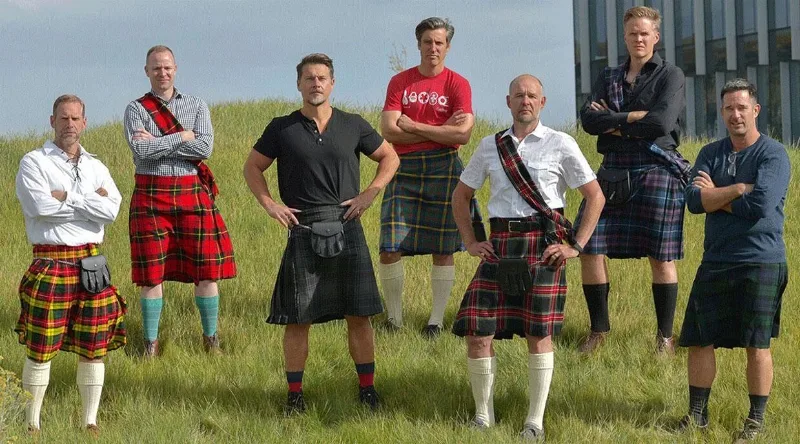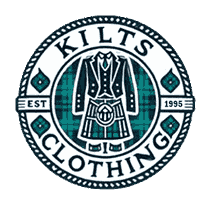Irish Kilts vs. Scottish Kilts: What’s the Difference?

Kilts are one of the most iconic garments of Celtic culture, symbolising pride, tradition, and heritage. While kilts are most commonly associated with Scotland, they also hold an important place in Irish history and culture. Both countries wear kilts to celebrate their national identity. Yet, the Scottish and Irish kilts differ in history, tartans, colours, and accessories.
Suppose you’ve ever wondered about the difference between Scottish and Irish kilts. In that case, this detailed guide will take you through their origins, styles, and cultural significance.
Table of contents
The History of Kilts in Scotland and Ireland
Scottish Kilts – From the Féileadh Mòr to the Modern Kilt
The history of the Scottish kilt goes back to the sixteenth century with the Féileadh Mòr, or the “great kilt.” It was a large, thick piece of woollen fabric that wrapped around the waist and draped over the shoulder. It was originally designed as a practical garment to protect Highlanders from Scotland’s unpredictable weather.
By the eighteenth century, Scottish kilts became a symbol of identity and unity among clans. After the Jacobite Risings of 1746, however, the British government banned the wearing of tartan and kilts, fearing that the clans would rise again. Despite the ban, the kilt survived and eventually evolved into the small kilt, or féileadh beag, which resembles the pleated kilt we know Today.
In the nineteenth century, kilts became even more popular during the Highland revival. The addition of pleats and buckles gave rise to the modern kilt, turning it from a purely practical garment into a proud symbol of Scottish heritage.
Irish Kilts – The Saffron Tradition
Irish kilts have a more modern history. Many believe that the Lein-croich, a long tunic, was the first Irish version of the kilt. However, this was not actually a kilt but rather a traditional tunic.
The true Irish kilt came about during the rise of Irish nationalism in the late nineteenth and early twentieth centuries. As Ireland pushed back against anglicisation, new traditions emerged, including the creation of Irish tartans to represent counties and districts.
The most iconic Irish garment is the Saffron Kilt, introduced in the early twentieth century and widely worn by the Irish military. This kilt is mustard yellow in colour, often decorated with green shamrock appliqués along the pleats. It became a symbol of Irish pride and is still worn Today by Irish pipe bands and military groups.
Tartan Differences – Clans vs. Counties
One of the biggest differences between Scottish and Irish kilts lies in the tartan.
- Scottish Tartans
- In Scotland, tartans are directly tied to clans and families. Each clan has its own tartan pattern, passed down through generations. Today, there are more than 7,000 registered Scottish tartans, representing surnames, military regiments, and regions. Wearing your clan tartan is a way to honour your ancestry and heritage.
- Irish Tartans
- In Ireland, tartans are connected to counties and districts instead of clans. For example, someone from Cork might wear the Cork County Tartan, while someone from Galway would wear the Galway tartan. This difference highlights how Irish kilts celebrate regional identity rather than family lineage.
👉 Today, both Scottish and Irish tartans are available for modern wear, allowing people to choose designs that reflect their roots or simply their personal style.
Kilt Accessories Compared
Crests and Symbols
- Scottish Tradition: Scots often wear clan crests pinned to their tartan, especially at weddings. For example, a bride may be welcomed into her new family by receiving their crest pinned to her tartan.
- Irish Tradition: In Ireland, crests are less common. Instead, many choose to pin a shamrock crest to their tartan, or sometimes leave it bare.
Sporrans
The sporran is the small pouch worn at the front of a kilt, serving as a pocket.
- Scottish sporrans often feature thistle or Celtic designs.
- Irish sporrans may have shamrocks and green detailing.
Functionally, they are the same, but design elements distinguish Scottish from Irish sporrans.
Jackets
- Scottish Jackets:
- Prince Charlie Jacket → formal wear, usually with a waistcoat, bow tie, and wing collar shirt.
- Argyll Jacket → semi-formal, versatile for daytime or evening events.
- Irish Jackets:
- Brian Baru Jacket → Irish equivalent of Prince Charlie, formal and elegant.
- Kilkenny Jacket → similar to Argyll, structured like a suit jacket, often in Irish green shades.
Hats
- Scots wear the Glengarry hat with full Highland dress, complete with a red-and-white check and a pom-pom on top.
- In Ireland, hats are less common in formal dress, though some bands may wear simple caps.
Socks and Shoes
Both Scottish and Irish traditional dress includes knee-high socks and Ghillie Brogues (shoes with laces tied around the ankle).
- Scots usually wear cream-colored socks, often with ribbons matching their tartan, and tuck a small knife called a Sgian-dubh into the top of the sock.
- The Irish military traditionally wears black socks with the saffron kilt.
Key Similarities Between Scottish and Irish Kilts
Despite their differences, both Scottish and Irish kilts share:
- A deep Celtic heritage.
- Use in ceremonies, military traditions, and weddings.
- Accessories like sporrans, jackets, and brogues.
- Representation of pride, identity, and cultural heritage.
Side-by-Side Comparison: Scottish vs Irish Kilts
| Feature | Scottish Kilt | Irish Kilt |
| Origin | 16th century (Féileadh Mòr) | 20th century (Saffron Kilt) |
| Tartan Meaning | Clan and family identity | County and regional identity |
| Common Colors | Wide range of tartans | Saffron yellow with shamrock motifs |
| Accessories | Clan crests, thistle sporrans, sgian-dubh | Shamrock crests, green-detailed sporrans |
| Formal Jackets | Prince Charlie, Argyll | Brian Baru, Kilkenny |
| Socks | Cream socks with tartan ribbons | Black socks with saffron kilt (military) |
Conclusion – Choosing the Right Kilt
Both Scottish and Irish kilts are powerful symbols of national pride and heritage. Scottish kilts have a longer history, tied to clans and families. In contrast, Irish kilts are more modern, often connected to regional identity and the saffron tradition.
Whether you admire the wide variety of Scottish tartans or the bold look of the Irish saffron kilt, both represent the beauty of Celtic culture.
👉 If you’re considering wearing a kilt for a wedding, formal event, or simply as a celebration of heritage, explore both Scottish and Irish styles to find the one that resonates most with your identity.
FAQs
The main difference between a Scottish kilt and an Irish kilt lies in their history, tartans, and colors. Scottish kilts date back to the 16th century and are linked to clans, with each family having its own tartan. Irish kilts are more modern, introduced in the 20th century, and are usually saffron yellow, often decorated with shamrocks. Instead of clan tartans, Irish kilts use county or district tartans to represent regional identity.
Yes. Unlike Scottish tartans, which represent clans, Irish tartans represent counties and districts.
Scottish kilts date back to the sixteenth century, while Irish kilts, particularly the saffron kilt, were introduced in the twentieth century.
The saffron yellow kilt is the most widely worn Irish kilt.
Yes. Men and women now wear both Scottish and Irish kilts as symbols of heritage and pride.

